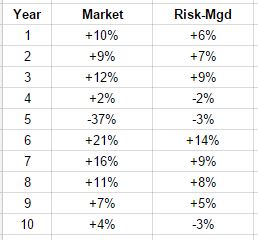A few years ago, the Las Vegas Review-Journal conducted a six month survey of the payout percentages of selected nickel slot machines in 70 Las Vegas casinos. The payout rates ranged from a low of 86.86% to a high of 93.42%. It should come as no surprise Continue reading
Category Archives: investment theory
Investing Is Like Judging Hogs at The County Fair
My youngest son is a member of a 4-H livestock judging club. Since he is too young to drive, I take him to the meetings and usually hang out to watch the proceedings. In a judging competition, the competitors are shown a group of four animals. They rank the animals 1 – 4 and then explain the reasons for their ranking to a judge. There is a lot of freedom allowed for the competitors to combine their imagination with technical jargon to come up with flowery descriptions (i.e. “flatter in his stifle” or “less condition over his loin edge” or “exceptionally long from the hooks to the pins”). Combining observation with verbal agility to argue your case is a nice skill to develop, but the reasoning isn’t enough by itself. Continue reading
Defense Wins Championships
Investors often take the words “defensive” or “conservative” as code for “being willing to accept small returns.” The truth is, playing defense can be the easiest way to boost your returns.
Most investors focus on offense. Finding the next Tesla or Google. Trying to figure out which sector will benefit most from next week’s GDP numbers. Who’s going to beat estimates and by how much, etc.
The problem with focusing solely on offense is that it’s almost impossible to possess an advantage. You use the same information to try to find the same opportunities as everyone else. For example, Continue reading
Can Risk Management Boost Returns? Hint: Yes
This is the second of two emails I recently sent to my fellow finance committee members (of a local non-profit organization). The topic we have been discussing is the investment performance of the organization’s endowment. The points in this message apply just as much to retirement investors as they do to charitable endowment or foundation investors…
One last comment on endowment returns and strategy. Our discussions of managing risk shouldn’t be taken as code for “willing to accept small returns.” The truth is, playing defense can be an effective way to boost returns.
Winning strategies almost always contain an element of sacrifice. A football team will run the ball, repeatedly and ineffectively, to open up the passing game later. Casinos offer gigantic progressive jackpots to lure you into a bank of slot machines. Letting small forest fires burn naturally can prevent hugely destructive fires later.
One factor that allows roundabout strategies like these to work is the difficulty of pulling them off. Fans yell at you for calling plays like a moron. Paying out a big jackpot wrecks the slots manager’s P&L for a few days. Sacrifice, even when it’s well thought out and planned in advance, almost always feels wrong while it’s happening.
To most investors, the obvious route to better performance is through more aggressive concentration in growth assets. You can make a lot of money doing this, the hard part is keeping it. The less obvious strategy is being willing to sacrifice, what looks like easy money now, in return for gaining the earning potential of playing defense. Of having some way of avoiding large losses in order to allow more capital to be conserved and available for compounding.
For example, let’s compare a set of hypothetical market returns to a set of hypothetical returns from a risk managed approach:
In this illustration, the market outperforms the risk-managed portfolio in nine out of ten years, some of those years by quite a bit. The managed portfolio has three negative years compared to only one for the market. Part of the reason for the persistent lag in the managed account is undoubtedly due to fees, so obviously the value of management is in question. But when you run the math over the entire period:
- Market total return = +50%
- Risk-Mgd total return = +60%
The moral of the illustration is that it’s not how often you match or beat the market that matters, it’s when you do it and by how much. In this example, playing defense in year five more than makes up for the relatively meager performance in every other year.
If our committee had coordinated the Risk-Mgd approach above, it would be easy to look back at ten years of completed returns and feel smug about the wisdom of it all. But in the real world, we would probably have spent 90% of the time feeling frustrated and talking about making changes.
I think the key for us is to not care about the market. Our focus should be on preserving and growing the endowment and doing our best to ensure that it can support the mission of the club when it needs to. That’s the only benchmark that really matters.
Disclaimer: The above example is hypothetical and is for illustrative purposes only. No specific investments were used in this example. Actual results will vary . Past performance is not indicative of future returns. Information displayed is taken from sources believed to be reliable but cannot be guaranteed. All indices are unmanaged and investors cannot invest directly into an index. Ideas and opinions expressed in this article are the sole responsibility of Patrick Crook/PLC Asset Management and do not reflect any stated opinions of LLP Financial LLC or any other person or entity.
Open Letter To The Finance Committee
For the last seventeen years I have served on the board and/or finance committee of a local non-profit organization. The message below was an email I sent in response to a recent meeting where the topic of the investment performance was discussed. The points in the message apply to retirement investors just as much as they do to charitable endowment or foundation investors…
This absurdly long email is in response to the discussion we had on Tuesday regarding the recent performance of the endowment. There was frustration expressed over the meager amount of growth over the last twelve months. I’m very much in support of the decision to review our strategy in the July meeting and the follow-up discussion with [investment advisor] in August. But before those meetings, there are a few things we should consider.
Tweaking Of Allocations Is Pointless
Finding the perfect mix of foreign and domestic stocks, bonds, real estate and commodities is not only impossible, it’s actually not that important. Continue reading



